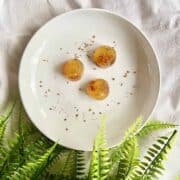Osmanthus jelly recipe
This osmanthus jelly recipe (Gui Hua Gao) is a refreshing, delicious, quick and easy Chinese dessert made from edible sweet osmanthus flowers. Its shimmering gold color and floral fragrance have kept it popular through the years- you can even find it at Michelin-star Chinese restaurants today!
Servings: 10 people
Calories: 58kcal
Equipment
- Pot
- Whisk
- Mold, Optional You can use a wide and shallow container to set the jelly instead of molds. If so, you will need a sharp knife to cut the jelly later.
Ingredients
Making jelly with 1 litre of water
- 0.35 oz Osmanthus Tea Leaves (10g)
- 0.7 oz Wolfberries Also known as goji berries. This is 20g. You can use more if you like, but don't go over 40g or the jelly will be too fibrous.
- Konnyaku powder Substitute: agar agar or gelatine (not vegan.) Amount as per back of your packet. If the amount of water required is not 1 litre, please adjust the rest of the ingredients accordingly. For example, if your packet only requires 500ml, please halve the rest of the ingredients used.)
- 4 Cups water 1 litre. Please see above.
- 5.3 oz granulated white sugar (150g, optional- only add if your konnyaku jelly packet does not already include sugar. Substitutes: Osmanthus syrup/ osmanthus sugar/ rock sugar/ a neutral honey
Instructions
- Rinse the woflberries then soak them in a bowl of hot water.
- Remove any hard and dark bits (leaves/ twigs) from the osmanthus flowers.
- Heat 1 litre of water in a pot. Whilst the water is heating, you may want to rinse the osmanthus flowers in a sieve. (This is an optional step as it removes dust but the wet flowers are difficult to get off the sieve!) When the water is almost boiling, add all the osmanthus flowers to the water. Let the osmanthus tea simmer for 5 minutes.
- Whilst the pot is simmering, mix the white sugar and konynyaku powder thoroughly. (Skip this step if using honey or rock sugar.)
- After 5 minutes, quickly add the konnyaku powder- sugar mixture (from the previous step) to the pot whilst whisking continuously. Bring the pot back to a boil before reducing the heat to a simmer. Whisk continuously and simmer for 3-4 minutes to get rid of any lumps. (This ensures that the jelly does not turn back into water after setting and that you don't have a lumpy jelly.)
- After the 3-4 minutes, add the goji berries. Do not pour the soaking water into the pot or it will affect the setting of the jelly- you can keep it for tea, stews or soups. Continue to simmer for 3 minutes.
- Pour the jelly into molds and allow to cool. Stir with a toothpick to ensure that the tea and wolfberries are dispersed evenly througout the jelly. When not too hot (you don't want to raise the temperature of your fridge), transfer to fridge to set for at least 3 hours (I usually leave it overnight)
- Alternatively: if you don't have fancy molds, just pour the jelly into a wide and shallow heat-proof container to set, then cut with a sharp knife or cookie cutters.
Notes
If you prefer a clear and non- fibrous jelly, increase the amount of time the osmanthus flowers are simmering for before sieveing them out (This is done before adding the konnyaku powder.)
IMPORTANT: just a reminder to take care as several kids have choked to death on konnyaku/ konjac jellies so if serving the very young or old, you may want to use agar agar or gelatine powder instead.
Nutrition
Calories: 58kcal | Carbohydrates: 15g | Protein: 0.01g | Fat: 0.05g | Sodium: 5mg | Potassium: 2mg | Sugar: 15g | Vitamin A: 19IU | Vitamin C: 0.3mg | Calcium: 3mg | Iron: 0.02mg
